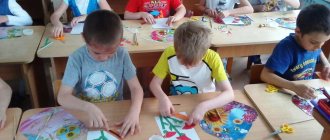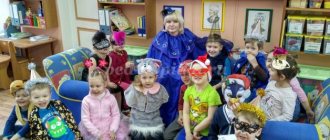Stages of work before bed: time plan
There are 3 stages of organizing daytime sleep.
- Preparation (15–20 minutes).
- Relaxation (5–7 minutes).
- Sleep (1–2 hours).
Preparation
The longest and most important stage. At the first stage, children play calm games.
Games for the first and second junior groups
Quiet games with objects:
- "Magic bag" The teacher invites the kids to put their pen into a bag of small toys and, without taking it out, guess what it is.
- “Pick up a figure.” Kids receive a set of geometric shapes (3-4 pieces) and blank stencils. Task: name the figurine and place it in the appropriate hole.
- Dominoes (lotto). If the kids are already familiar with team games, then you can offer them dominoes, in which animals are depicted on all the dice. Task: players need to find among their chips the one that will continue the line on the table.
Games for the middle group
Games for the middle group may include tasks for quick wits and ingenuity (but not only):
- Folding given figures from mosaic elements occupies a leading place in the card index of games before bedtime for children 4–5 years old.
Mosaics and construction sets not only train coordination, develop the child’s thinking processes, but also perfectly relax
- "Sharp eye". We show the children a jar or bowl. Their task is to estimate the diameter of the container opening and cut out a lid of the appropriate size from cardboard. The one whose cap matches exactly wins.
- "Repetition." The teacher names a topic (usually close to the one that was in the lesson before lunch), on which the children select words. The kids complete the task one by one, and when they say their word, they repeat those that were voiced earlier.
Games for senior and preparatory groups
These can also be motor games, after which you can tell a fairy tale or do breathing exercises:
- “Grandma went to the market and bought...” The presenter says: “Grandma went to the market and bought a meat grinder” - he imitates the movement of the meat grinder with his hand. The next participant says the same phrase, but instead of a meat grinder he names something of his own (for example, a coffee grinder, a sewing machine). After the arms, movements for the legs are called (the main thing is that the “purchase” can be shown with a simple movement). Imitating the movement of the named object, the child does not stop turning the meat grinder. The point is to do all the movements at the same time.
- "This is my nose." The kids sit in a circle. One touches his chin and says, “This is my nose.” His neighbor touches his nose but says, “It’s my chin.” The point is to talk and show different parts of the body (you can limit yourself to one face or head).
- "King of Silence" One baby - the king - sits on a chair, the rest stand around him. The monarch points to any child and gestures to him. This is how he chooses his ministers. If the “minister” makes even the slightest noise along the way, he is eliminated. It’s the same with the king: if he makes a noise, then he is overthrown from the throne and put in this place the first minister, who reached the royal person silently.
It is advisable to involve all the children in the games.
Fairy tales
Children love fairy tales very much. And in younger groups, due to age-related slowness, there is no time left for games, so reading aloud is the best technique. Although older children will be happy to listen to the exciting story.
- "The Tale of the Deer Who Couldn't Sleep."
- Iris Review “How Tisha searched for sleep.”
- Andrey Prokofiev "Hare's Foot".
- "The Tale of the Rhino who Couldn't Sleep."
- Natalya Yashchenko “How the Striped Tiger Cub was looking for treasure”, etc.
Poems
At the preparation stage, after playing and reading fairy tales, children go to the toilet and carry out hygiene procedures: they wash their hands, in the summer - their feet, and wash themselves. The younger ones do this with the help of a teacher and an assistant teacher. Adults accompany all actions with poems (especially important for children, whose actions are better organized by such rhymes); older children recite them together with their teachers.
- Jump-jump, jump-jump, We'll sit down on the potty. We ate, we drank, we almost forgot about him! Obedient kids Do little things: A-a-a and pee-pee-pee. Just don't rush!
Preparing for bed in the younger group begins with putting the kids on the potties
- Good water! Help a little: Wash the kids’ dirty palms! You, a piece of soap, wash us without sparing, Our hands will become cleaner and whiter!
Hygiene is given special attention before bedtime
- Water, water, Wash my face, So that my eyes shine, So that my cheeks blush, So that my mouth laughs, So that my teeth bite.
Game situation
It's time for the kids to undress, fold their things and put on their pajamas. The process of undressing can be turned into a game “We are already quite big.”
Instructions:
- “Children, let's see if you have matured this day. First, we’ll tell you in what order you need to take off your clothes.”
- The children do it. Either everyone speaks in turn, or one person named by the teacher speaks.
- “Now we need to put things on the high chair.” Children do it, adults help.
- "Great! I see that you are already quite big. But you probably won’t be able to put on your pajamas without my help...” The children, spurred on by the excitement of the teacher’s doubts, get dressed.
Creating game situations speeds up the process of undressing and dressing for bed
Alternatively, you can come up with a story about the Bella doll, which can’t remember in what order you need to take off your clothes: first the shoes, and then the dress, or vice versa? Many children, regardless of age, have difficulty keeping things in order. For such guys, you can use the story about Mitya, who after sleep was constantly dirty.
Instructions:
- “Children, look who came! This is Mitya, he is also going to bed. Oh, he’s upset for some reason and doesn’t want to go to bed... What happened? It turns out that Mitya is a very neat boy, but every time after sleep his clothes turn out to be dirty and wrinkled. And all because the boy, when undressing, does not fold his things, but crumples them. And he puts shoes on top.”
- “Let’s tell Mitya how to fold clothes.”
- Children talk. (It is advisable to take turns, after the teacher gives the floor. Otherwise, they will talk vying with each other).
- "Great! You said everything correctly, and now Mitya and I are going to bed.”
Relaxation
This stage is appropriate to carry out with calm music, which has a general calming effect. The best option is the sounds of nature (the noise of the forest, the murmur of a stream, etc.).
Breathing exercises
Before the kids go to bed, they are given 1-2 exercises (for the younger group), 2-3 for the middle, senior and preparatory groups.
"Rose and Dandelion"
Instructions:
- We stand up straight, imagine that we are holding a rose in our hand, and inhale its aroma.
- And in the other hand there is a dandelion. We blow on it, exhaling.
- Repeat 3-4 times.
"Breath"
- Quietly, quietly we will breathe, we will hear our hearts.
Instructions:
- The initial pose is standing, arms extended at the seams.
- We inhale through the nose until the air begins to expand the chest.
- We freeze for 4–5 seconds.
- We also exhale through the nose.
- Repeat 2-3 times.
Breathing exercises help children relax
Games with rewards
Reward games can be used to encourage sleep in older children.
Table: games with encouragement for organizing sleep (fragment of the master class “Time to sleep, or how to organize sleep in kindergarten”)
| Option #1 | Before going to bed, the teacher tells the children that they are starting a competition “Who will fall asleep first.” After the sleepy hour, the teacher chooses the winners: 1st, 2nd and 3rd place - who, in turn, fell asleep earlier. The teacher singles out each winner by raising his hand and presents him with a medal. The medals are transferable; the next day other children can receive these medals. |
| Option No. 2 | Before going to bed, you can arrange one more trick. You can offer the children a condition: for the children who are the best at pretending so that the teacher (or character) thinks that they have fallen asleep, after a quiet hour there will be a surprise (at the teacher’s choice - for example, you can buy stickers, chips or other interesting things for children as a gift). inexpensive item). But pay attention to the fact that this will not be easy to do; you need to relax, lie down comfortably and close your eyes without opening them. Children will try to pretend and fall asleep. |
| Option #3 | Use a cumulative bonus system. We also choose winners - who fell asleep first, and collect tokens for each child during the week. At the end of the week, we count the number of tokens and reward the winners. |
| Quote by: Skovorodko E.V., teacher of the Municipal Budgetary Educational Institution “Sinekolodetskaya Elementary School-Kindergarten”. Reward games for sleep management | |


